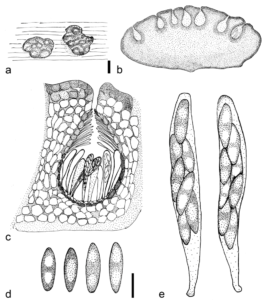Fungalpedia – Note 249, Coccodiella
Coccodiella Hara.
Citation when using this entry: Aumentado et al. 2024 (in prep) – Fungalpedia, plant pathogens.
Index Fungorum, Facesoffungi, MycoBank, GenBank, Fig 1.
Classification: Phyllachoraceae, Phyllachorales, Sordariomycetidae, Sordariomycetes, Pezizomycotina, Ascomycota, Fungi
Coccodiella was introduced by Hara (1911) as a biotrophic genus of the Phyllachoraceae to accommodate Coccodiella arundinariae as the type species based on its morphology, causing tar spots on Arundinaria simonii in Japan. Coccodiella is characterised by the formation of a sessile hypostroma with erumpent black epistroma on host tissue, scattered or aggregated, flattened to pulvinate, uni- to multiloculate with immersed perithecia, cylindrical to clavate asci, globose to ellipsoid, aseptate, and hyaline ascospores without a gelatinous sheath. Hara (1911) initially made an inaccurate characterisation of ascospores as biseptate, however, Hara (1912) corrected it as aseptate. Other authors have partly revised this genus, all the relevant known species were synonymised and transferred to Coccodiella (Katumoto 1968). Coccodiella is closely related to Camarotella spp. with erumpent stroma and graminicolous Phyllachora spp. with immersed perithecia; however, Coccodiella mainly differs from Camarotella and Phyllachora by the structure of the stroma and the range of host plants (Mardones et al. 2017).
Members of Coccodiella are host-specific and distributed in tropical areas, with known Coccodiella species occurring on plant species belonging to nine host plant families (Mardones et al. 2018), and only the type species found in Poaceae in Japan, while most species are parasitic in the leaves of Melastomataceae in America (Miller & Burton 1943). Index Fungorum (2024) listed 21 Coccodiella species with five species with molecular sequence data of mostly LSU and SSU while other species have ITS, tef1-α, and rpb2 (Mardones et al. 2017).
A study on the pathogenicity of Coccodiella miconiae on Miconia calvescens (Melastomataceae) by Alves et al. (2014) resulted in the formation of yellow pustules on the leaves. Inoculation of ascospores suspension led to necrosis and subsequent dropping of leaves in young plants (Alves et al. 2014). However, no pathogenicity data have been reported for other plant disease-associated Coccodiella species.
Type species: Coccodiella arundinariae Hara
Other accepted species: (Species Fungorum – search Coccodiella)
Figure 1 – Coccodiella arundinariae. a Stroma on a leaf. b, c Vertical section through the stroma. d Ascospores. e Asci. Scale bars: a = 1 mm; d = 10 µm. Redrawn from Hara (1911).
References
Hara K. 1911 – New genus of the fungus on Arundinaria simoni. Bot Mag Tokyo 25, 222–225.
Hara K. 1912 – On Coccoidiaceae. Bot Mag Tokyo. 26, 139–44.
Index Fungorum. 2024 – https://www.indexfungorum.org/names/NamesRecord.asp/
Katumoto K. 1968 – On the genus Coccodiella Hara. Journal of Japanese Botany 43, 277–284.
Entry by
Herbert Dustin R. Aumentado & Johnny Louangphan, Center of Excellence in Fungal Research and School of Science, Mae Fah Luang University, Chiang Rai, Thailand
(Edited by Ruvishika S. Jayawardena, Kevin D. Hyde, Samaneh Chaharmiri-Dokhaharani, & Achala R. Rathnayaka)
Published online 22 April 2024
